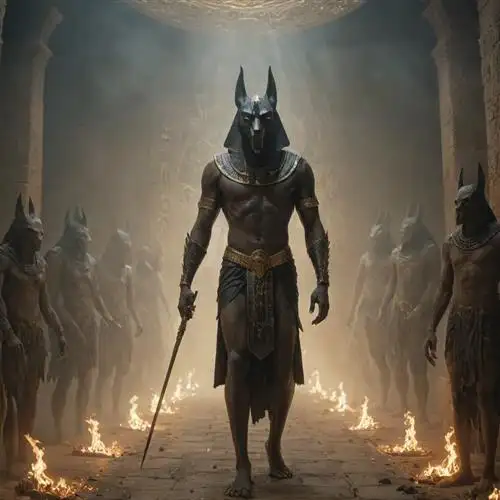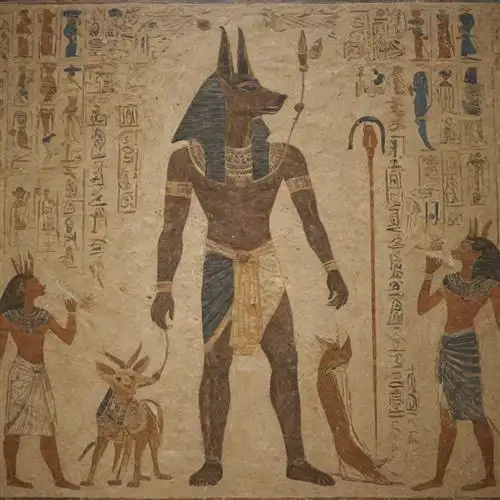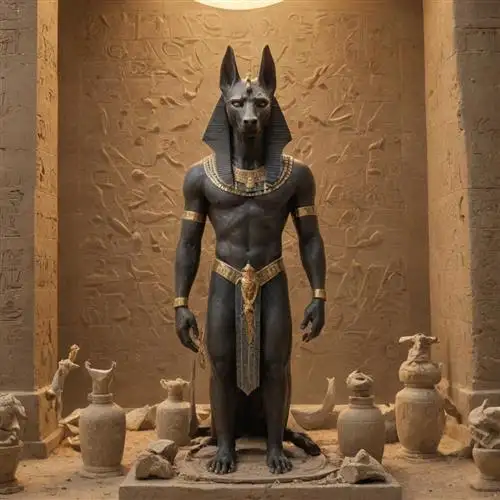
The Origins of Anubis Symbolism
Anubis, the jackal-headed deity, is one of the most iconic and enigmatic figures in ancient Egyptian mythology. This mysterious god's origins can be traced back to the predynastic period, where he was worshipped as a guardian of the dead and a psychopomp, guiding the souls of the deceased to the afterlife. The symbolism and significance of Anubis have evolved over the centuries, reflecting the deep-rooted beliefs and cultural traditions of the ancient Egyptians.
The jackal, the animal associated with Anubis, was a common sight in the Egyptian landscape, particularly in the desert regions. These scavengers were often observed near the tombs and burial sites, leading the ancient Egyptians to associate them with the realm of the dead. The jackal's ability to navigate the liminal spaces between the living and the dead, coupled with its keen sense of smell, made it an ideal candidate for the role of the guardian of the necropolis.
Anubis's iconography further solidifies his connection to the funerary rites and the afterlife. The god is often depicted with a jackal head, sometimes with a human body, and is shown standing guard over the deceased, overseeing the mummification process, or accompanying the soul of the departed on its journey to the underworld. The black color associated with Anubis is believed to symbolize both the color of the fertile Nile soil, as well as the color of the decomposing bodies, further reinforcing his role as a deity of the dead.
The cult of Anubis gained significant prominence during the Old Kingdom, when the god's temples were established in important necropolis sites, such as Abydos and Saqqara. These temples served as centers of worship and funerary practices, where the rituals of mummification and the preparation of the dead for the afterlife were carried out. Anubis's central role in the funerary rites is further highlighted by his presence in the Book of the Dead, a collection of spells and incantations that guided the deceased through the afterlife.
Over time, Anubis's role expanded beyond the realm of the dead, as he became associated with other aspects of Egyptian belief and mythology. He was sometimes depicted as a protector of the living, guiding and guarding individuals through the dangerous and uncertain paths of life. Anubis's status as a psychopomp, a guide of souls, also led to his inclusion in the pantheon of deities who presided over the weighing of the heart ceremony, a crucial step in the judgment of the deceased in the afterlife.
Anubis and the Afterlife
Anubis, the jackal-headed deity, holds a profound significance in ancient Egyptian mythology, particularly in his role as the guardian of the afterlife. As one of the most iconic and enduring symbols of Egyptian culture, Anubis' association with the realm of the dead has long captivated the imagination of scholars and enthusiasts alike.
At the heart of Anubis' connection to the afterlife lies his role as the embalmer and protector of the dead. During the mummification process, Anubis was believed to oversee the delicate task of preserving the body, ensuring the deceased's safe passage into the next life. This sacred duty was not only a practical one but also a symbolic representation of Anubis' role as a intermediary between the living and the dead.
Beyond his role as the embalmer, Anubis was also responsible for guiding the souls of the deceased through the treacherous journey of the underworld. In the famous "Book of the Dead," Anubis is depicted weighing the heart of the deceased against the feather of truth, a critical step in determining their worthiness to enter the afterlife. This weighing of the heart, known as the "Judgement of the Dead," was a pivotal moment in the Egyptian conception of the afterlife, where Anubis acted as the impartial overseer of this crucial process.
Interestingly, Anubis' association with the afterlife extends beyond his role as the embalmer and guide. In some ancient Egyptian beliefs, Anubis was also believed to be the protector of the deceased, guarding their tombs and ensuring the safety of their souls in the afterlife. This protective aspect of Anubis' character underscores the deep reverence and respect the ancient Egyptians held for this powerful deity.
Moreover, Anubis' connection to the afterlife was not limited to his role in the mummification process and the judgement of the dead. He was also believed to have the ability to facilitate the transformation of the deceased into the divine form of the jackal, a symbol of rebirth and renewal. This belief highlights the multifaceted nature of Anubis' function in the Egyptian conception of the afterlife, where he served as both a guide and a facilitator of the deceased's journey to the next life.
Anubis as the Jackal-Headed God
Anubis, the enigmatic jackal-headed god of ancient Egyptian mythology, has captivated the imaginations of scholars and enthusiasts alike. Beyond the iconic imagery, Anubis holds a profound significance within the complex tapestry of ancient Egyptian symbolism. Revered as the guardian of the dead and the protector of the mummification process, Anubis' role was pivotal in the intricate rituals and beliefs surrounding the afterlife.
As the jackal-headed god, Anubis' animalistic form holds deep symbolic meaning. The jackal, a common sight in the deserts of Egypt, was believed to possess a keen sense of the underworld, often scavenging near burial sites and tombs. This association with the liminal spaces between life and death elevated Anubis to a position of great importance, as he was tasked with guiding the deceased through the treacherous journey to the afterlife.
Anubis' role as the embalmer and protector of the dead was central to the mummification process, a complex and sacred ritual that ensured the safe passage of the deceased to the afterlife. During the mummification rites, Anubis would oversee the delicate process of removing the internal organs, preserving the body, and wrapping the remains in linen. This meticulous care and attention to detail were crucial, as the preservation of the physical form was believed to be essential for the soul's continued existence in the afterworld.
In addition to his role as the guardian of the dead, Anubis also held sway over the weighing of the heart ceremony, a pivotal moment in the ancient Egyptian conception of the afterlife. During this ritual, the deceased's heart was weighed against the feather of truth, representing the moral and ethical balance of the individual's life. Anubis, as the guide and overseer of this process, ensured the fair and impartial judgment of the soul, determining its ultimate fate in the afterlife.
The symbolism of Anubis extends beyond the realm of the dead, as he was also associated with the protection of the living. In certain funerary texts and amulets, Anubis was invoked to provide safeguards against spiritual and physical threats, offering a sense of security and divine guidance to those who sought his protection. Anubis Rituals - Secrets the Experts Don't Want You to Know delve deeper into the arcane practices and beliefs surrounding this enigmatic deity.
Anubis in Egyptian Mythology and Art
Anubis, the jackal-headed deity, held a profound significance in ancient Egyptian mythology and art. As the god of embalming and the protector of the dead, Anubis played a crucial role in the intricate rituals and beliefs surrounding the afterlife.
One of the most distinctive features of Anubis was his iconography. The jackal-headed figure, with its sharp features and pointed ears, was a powerful representation of the god's role as the guardian of the necropolis, the sacred burial grounds. This iconic depiction was not merely a symbolic representation but also reflected the deep connection between Anubis and the natural world, as the jackal was a common sight in the desert regions surrounding ancient Egyptian settlements.
In Egyptian mythology, Anubis was believed to be responsible for the embalming and mummification process, guiding the deceased through the complex rituals that ensured a successful transition to the afterlife. As the god of the dead, Anubis was also tasked with weighing the heart of the deceased against the feather of truth, a crucial step in the judgment of the soul. This process, known as the "Weighing of the Heart," was depicted in numerous funerary texts and artworks, further solidifying Anubis's role as a central figure in the Egyptian conception of the afterlife.
The significance of Anubis extended beyond his role in the afterlife rituals. In ancient Egyptian art, the god was often depicted in a variety of contexts, including funerary processions, temple scenes, and even in the form of amulets and statues. These artistic representations not only served to honor and revere Anubis but also conveyed the deep-rooted beliefs and cultural traditions of the ancient Egyptians.
Moreover, Anubis's influence extended beyond the realm of the dead and into the world of the living. As the god of embalming, Anubis was believed to possess the knowledge and skills necessary to preserve the physical body, which was seen as a crucial component of the afterlife journey. This reverence for Anubis's abilities led to the development of specialized embalming practices and the emergence of a class of priests dedicated to the rituals associated with the god.
The Symbolic Meaning of Anubis's Attributes
Anubis, the ancient Egyptian deity associated with mummification and the afterlife, is renowned for his unique iconography. Each aspect of Anubis's physical form carries profound symbolic meaning, offering insights into the multifaceted nature of this revered godly figure.
Anubis's canine head is one of the most recognizable features, symbolizing his role as the guardian of the dead. The jackal-headed deity was believed to guide the souls of the deceased through the treacherous underworld, protecting them from the dangers that lurked in the afterlife. The canine association also connects Anubis to the ability to navigate the realms between the living and the dead, serving as a bridge between the mortal and the divine.
The black color of Anubis's skin is another distinctive attribute, imbued with deep symbolic significance. Black was often associated with the fertile soil of the Nile River, which was seen as the source of life and regeneration. In the context of Anubis, the black color symbolizes the transformative power of death, signifying the decomposition and subsequent rebirth of the deceased in the afterlife.
Anubis's role as the embalmer of the dead is reflected in his association with the embalming tools he is often depicted holding. The was-scepter, a long staff with a curved end, symbolizes Anubis's authority and power over the mummification process. The ankh, the ancient Egyptian symbol of life, represents the divine life-giving force that Anubis bestows upon the deceased, ensuring their successful transition to the afterlife.
The scales of justice, which Anubis is often shown weighing the hearts of the dead against the feather of Ma'at (the goddess of truth and justice), symbolize the crucial role he played in determining the fate of the deceased. This ritual, known as the "Weighing of the Heart," was a pivotal moment in the journey to the afterlife, where Anubis assessed the moral worth of the individual's soul.















